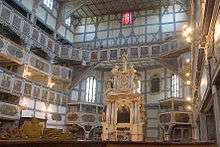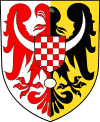Jawor
| Jawor | ||
|---|---|---|
|
Town hall | ||
| ||
 Jawor | ||
| Coordinates: 51°03′N 16°12′E / 51.050°N 16.200°E | ||
| Country |
| |
| Voivodeship | Lower Silesian | |
| County | Jawor County | |
| Gmina | Jawor (urban gmina) | |
| Government | ||
| • Mayor | Emilian Bera | |
| Area | ||
| • Total | 18.8 km2 (7.3 sq mi) | |
| Population (2006) | ||
| • Total | 24,347 | |
| • Density | 1,300/km2 (3,400/sq mi) | |
| Time zone | CET (UTC+1) | |
| • Summer (DST) | CEST (UTC+2) | |
| Postal code | 59-400 | |
| Car plates | DJA | |
| Website | http://www.jawor.pl | |
Jawor [ˈjavɔr] (German: Jauer) is a town in south-western Poland with 24,347 inhabitants (2006). It is situated in Lower Silesian Voivodeship (from 1975–1998 it was in the former Legnica Voivodeship). It is the seat of Jawor County, and lies approximately 61 kilometres (38 mi) west of the regional capital Wrocław.
In the town can be found a Protestant Church of Peace. It was named a UNESCO World Heritage Site in 2001. Jawor Castle lies in Jawor.
The name Jawor is Polish for "sycamore". Prior to 1945, the town was part of Poland, Bohemia, Austria, Prussia and Germany. After World War II the region was placed under Polish administration and ethnically cleansed according to the post-war Potsdam Agreement. The native German populace was expelled and replaced with Poles.
Notable residents
- Nicholas Magni (1355–1435), theologian
- Christoff Rudolff (1499-1545), author of the first German textbook on algebra
- Heinrich Gottfried von Mattuschka (1734–1779), German botanist
- Gerhard Bersu (1889-1964), German archeologist
- Max Otto Koischwitz (1902–1944), Nazi propagandist
- Heinz Finke (1920–1996), German officer
Gallery
-

Church of Peace
-

Church of Peace, interior
-
Buildings in Jawor
-
Jawor old market square
-
Frescoe in the church
External links
- Official site
- Local flags
- Jewish Community in Jawor on Virtual Shtetl
- Church Of Peace in Jawor - photo gallery
| Wikimedia Commons has media related to Jawor. |
Coordinates: 51°03′N 16°12′E / 51.050°N 16.200°E

